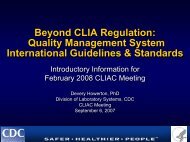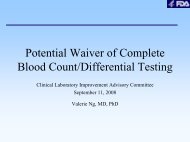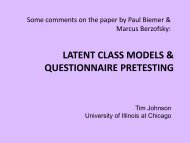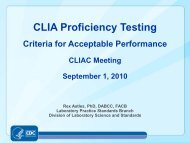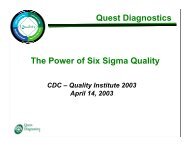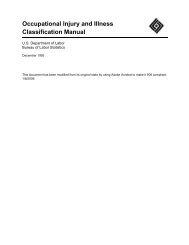Addendum L
Addendum L
Addendum L
- No tags were found...
Create successful ePaper yourself
Turn your PDF publications into a flip-book with our unique Google optimized e-Paper software.
Patricia CharachePublic Comment: Waived TestingCLINICAL LABORATORY IMPROVEMENT ADVISORY COMMITTEE MEETINGSeptember 17 – 18, 2003Patricia Charache, M.D.Professor of Pathology, Medicine, and OncologyJohns Hopkins Medical InstitutionsWaived Testing Criteria:PUBLIC COMMENT FORMThis discussion addresses criteria to be applied to decide which tests are to be placed in the waivedcategory, rather than in the categories of moderate or high complexity. It is understood that tests in thewaived category are exempt from CLIA oversight, including documentation that the test is beingperformed per manufacturer’s directions.AdvaMed has proposed that tests be waived if pre-market tests show that both trained and untrained usersget the same answers when given the manufacturers directions, e.g. package insert. This discussionprovides examples of three categories of issues required for safe and effective performance ofpatient care tests that would not be covered by the approach suggested by AdvaMed.Issue 1:The AdvaMed proposal presumes that in the real world, users will follow manufacturer’s directions, asthey do in the proposed assessment situation in which testers are provided the manufacturer’s directions,and told to follow them. The studies of CMS of waived testing laboratories in 8 states, have documentedthat in the real world, at least 50% of laboratories fail to follow manufacturer’s directions. (Otherstudies by OIG, by state oversight organizations, and others confirm this problem.)A real-life example may be seen with urine dip-sticks—perhaps the simplest, and longest practicedwaived test. Surveys of users asked when the tests on the stick should be read, predictably report thatthey should be read at one minute. In truth, to be accurate, the timing for different tests on the stickranges between 30 seconds and two minutes. One physician at my institution with responsibility fortraining residents and fellows indicated that they were well trained because they only looked at two testswith their one minute reading, e.g. leukocyte esterase and nitrate reductase. He was astonished to learnthat these two are the tests that require two minute incubations for accuracy.Issue 2:A key requirement for waived tests is that it be not only simple to perform, but also unlikely to causeharm if misread. There are 4 inherent causes of high risk for patient harm when tests are waived: 1)Risks of harm inherent in the test itself; (this will not be discussed); 2) Risks due to failure to followmanufacturer’s directions; 3) Judgment failures caused by lack of training, and 4) Off label use.Risks due to failure to follow manufacturer’s directions leading to erroneous results: A real-worldexample pertains to direct observation of the ability of a group of skilled nurses to perform hemaglobinmeasurements in a labor and delivery suite. Despite the fact that the waived test involved only fingerstickblood and an excellent, simple device, three successive nurses made very major mistakes. The firsttested a specimen with a bubble in the cuvette, seriously risking unnecessary transfusion for the patient,the second tested a sample in which blood had spilled on all sides of the cuvette, contaminating thedevice, and risking erroneous values for all subsequent tests. The third nurse put in the cuvette upsidedown. Thus three sequential nurse users who were multi-tasking in a high intensity area, failed to follow1
Patricia CharachePublic Comment: Waived Testingmanufacturer’s directions, and put patients at serious risk of harm, through exposure to possibletransfusion of un-needed blood, and to potential failure to transfuse when warranted.Risk of harm due to judgment calls: The untrained are unlikely to recognize when a test not performingproperly. A real-world example is that of the excellent hemaglobin device described above. One entirelot of cuvettes proved defective. Our institution was the only user that recognized this fact, and workedwith the manufacturer to identify the problem—all other waived users of the product had to have obtainedhighly erroneous values that varied with the individual cuvette used on a given patient. The users werenot equipped to understand when or how to recognize a defective product or test run.Risk of harm due to “off label” use: When a device is waived, it is used for any purpose, not just thosefor which it has been approved for the waived category. Although “off label use” is a recognized problemon the part of the FDA, such use has never been tracked, monitored, or appropriately re-classified andreviewed by CMS as a high complexity device (which it becomes, under CLIA, when manufacturer’sdirections are not being followed.) Thus a glucose meter waived for home use by a single patient, is usedin hospitals to monitor insulin dosing in critically ill patients. Home use devices are not built to be asaccurate as usual patient care chemistry devices, commonly having an accuracy of plus or minus 20%--fine for at home monitoring, not fine for hospital uses. In the hospital, it has been shown that diabeticsurgical patients heal most rapidly when their glucose level is maintained at 105 mg./dl, e.g. insulin isgiven for values above 105, or withheld below it. Untrained users do not understand the inability of thesedevices to achieve such accuracy, so that patients incur wide swings, and are at risk for inappropriatedosing. We have experienced patients put into coma through inappropriate insulin dosing for otherreasons as well, including testing delays after finger sticks, inappropriate finger stick technologiesincluding obtaining specimens from fingers coated with lotions, spilled fruit juice, etc, in which the errorwas not perceived by the operator. Similarly, devices approved to monitor anticoagulant levels onpatients are designed to screen for abnormalities, with abnormal results to be checked in a standardlaboratory. Known “off label use” includes monitor in patients to determine if they can have invasiveprocedures—a use for which the devices have not been designed, risking major harm.Issue 3:Failure to address pre-and/or post-analytical components of a test: The AdvaMed approachconsiders only the analytical part of a laboratory test, ignoring the pre-analytical factors such aspatient identification, specimen procurement, etc., and the post-analytical component, e.g. thetwo components of a test shown by the Institute of Medicine study to be responsible for 70% offatal, avoidable errors in laboratory testing, the analytical component being responsible for only30% of serious errors. Key pre-analytical considerations include problems with patientidentification and specimen procurement. Key post-analytical errors include appropriateinterpretation of the test, and failure by the care-giver to take required post-analytical actions.Real world examples include failure to follow a screening test with a confirmatory test, as wellas failure to take appropriate clinical actions. An example of the latter problem is seen withwaived tests for influenza A and B, for which sensitivity may be as low as 50%. Harm occursfor patients given a false negative result when they are denied appropriate anti-viral therapywhen it would have been warranted. Harm occurs from a public health perspective when apatient with influenza is returned to a nursing home, or other health-related location where theycan unknowingly spread the disease to fragile populations.Conclusion: The AdvaMed recommendation that a working group be convened to assist inrecommending straight forward policies to be used to classify tests for the waived category is an2
Patricia CharachePublic Comment: Waived Testingimportant, thoughtful recommendation. Waived tests, using simple methods provide animportant medical resource that must be protected, and appropriately advanced, andmanufacturers must know in advance what criteria are to be used to classify their products.The criteria, and follow-up monitoring if appropriate, must, however, understand and consideramong other factors, those illustrated above, namely steps to ensure that manufacturer’sdirections will be used, assessments consider risk of harm in the real-life usage environment,including off label use monitoring, and that pre-and post analytical components of a test beaddressed, not just the analytical component.3





